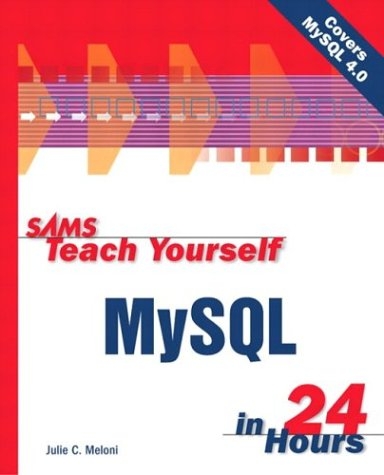
Sams Teach Yourself MySQL in 24 Hours
Sams Publishing (Verlag)
978-0-672-32349-2 (ISBN)
- Titel ist leider vergriffen;
keine Neuauflage - Artikel merken
Sams Teach Yourself MySQL in 24 Hours teaches the reader everything from basic installation to using MySQL in Web application development.
First, the basic concepts of database design are taught, and then the reader jumps right into planning and creating a database. The book then walks the reader through all the basics of using MySQL - working with tables and data, using MySQL's query functions, using transactions, and database administration - before the reader finally learns to put everything together to properly create the foundation database for a Web-based application.
Julie Meloni is the technical director for i2i Interactive, a multimedia company located in Campbell, CA (that's just down the street from San Jose). She's been developing Web-based applications since the Web first saw the light of day and remembers the excitement surrounding the first GUI Web browser. She is the author of several books and articles on Web-based programming languages and database topics, and you can find translations of her work in several languages, including Chinese, Italian, Portuguese, and Polish.
(NOTE: Each chapter concludes with a Summary, Q&A, and Workshop.)
Introduction.
I. INTRODUCTION TO MYSQL AND RELATIONAL DATABASES.
Hour 1. Introducing MySQL.
What Is a Relational Database? What Is MySQL? Communicating with MySQL.
Hour 2. Understanding Database Terminology.
Basic Elements Explained.
Hour 3. Learning the Database Design Process.
The Importance of Good Database Design. Types of Table Relationships. Understanding Normalization. Following the Design Process.
II. SETTING UP YOUR ENVIRONMENT.
Hour 4. Using the MySQL Client.
Working with the MySQL Command-Line Interface. Working with the MySQL Administration Tools. Other Interfaces to MySQL.
Hour 5. Securing MySQL.
Basic Security Guidelines. Introducing the MySQL Privilege System. Working with User Provileges.
III. LEARNING TO PLAN FOR YOUR DATABASE-DRIVEN APPLICATIONS.
Hour 6. Planning and Creating Your Database.
Determine Your Goals. Conceptualize the Tables. Creating the Database.
Hour 7. Creating Your Database Tables-Part I.
Learning the MySQL Data Types. Learning the Table Creation Syntax.
Hour 8. Creating Your Database Tables-Part II.
Identifying Keys in Your Tables. Adding Indexes to Your Tables. When to Use, or Not to Use, Keys and Indexes. Finalizing Your Table Creation Statements. Issuing Your Table Creation Statements.
IV. WORKING WITH YOUR TABLES.
Hour 9. Populating Your Database Tables.
Using the INSERT Command. Importing Data from Other Databases.
Hour 10. Selecting Data from Your Tables.
Using the SELECT Command. Using WHERE in Your Queries. Using Operators in WHERE Clauses. String Comparison Using LIKE.
Hour 11. Advanced Usage of SELECT Statements.
Using the GROUP BY Clause. Using SELECT Within INSERT Statements. Selecting from Multiple Tables. Using JOIN.
Hour 12. Modifying and Deleting Data.
Using the UPDATE Command to Modify Records. Using the REPLACE Command. Using the DELETE Command.
Hour 13. More About DELETE.
Deleting Related Records. Listing Tables and Databases Before Deleting Them. Using the DROP Command.
Hour 14. Modifying Table Structure.
Using DESCRIBE to View Table Structure. Renaming Tables. Using the ALTER Command.
V. USING BUILT-IN FUNCTIONS IN MYSQL QUERIES.
Hour 15. Using MySQL String Functions.
Frequently Used String Functions. Obscure String Functions.
Hour 16. Using MySQL Numeric Functions.
Using Numeric Functions in Queries.
Hour 17. Using MySQL Date and Time Functions.
Using Date and Time Functions in Queries. Formatting Dates and Times. Performing Date Arithmetic. Special Functions and Conversion Features.
VI. USING TRANSACTIONS.
Hour 18. Transactions Overview.
What Are Transactions? Transaction-Safe Table Types in MySQL.
Hour 19. Practical Transaction Usage.
Converting Tables to Transaction-Safe Table Types. Using Transactions in Your Applications.
VII. ADMINISTERING YOUR MYSQL SERVER.
Hour 20. Optimizing and Tuning Your Database.
Building an Optimized Platform. MySQL Startup Options. Optimizing Your Table Structure. Optimizing Your Queries.
Hour 21. Backing Up and Restoring Your Database.
Database Backup Overview. Using mysqlhotcopy. Using the BACKUP TABLE and RESTORE TABLE Commands. Using myisamchk.
Hour 22. Basic Administrative Commands.
Using the FLUSH Command. Using the SHOW Command.
VIII. INTERFACING WITH MYSQL.
Hour 23. Using MySQL with Perl.
Getting Access to Perl. Connecting to MySQL with Perl. Executing Queries. Working with MySQL Data.
Hour 24. Using MySQL with PHP.
Getting Access to PHP. How PHP Works. Connecting to MySQL with PHP. Working with MySQL Data.
IX. APPENDICES.
Appendix A. Installing MySQL.
How to Get MySQL. Installing MySQL 3.23 or 4.0 on Windows. Installing MySQL 3.23 or 4.0 on Linux/UNIX. Troubleshooting Your Installation.
Appendix B. Using MyODBC.
Installing MyODBC on Windows. Configuring MyODBC. Importing/Exporting Data with MysQL and Microsoft Access.
Appendix C. Reserved Words.
Appendix D. Practical MySQL/PHP Examples.
Creating Access Logs and Reports. Creating an Online Poll. Storing Uploaded Files in Your Database. Retrieving Images Files from Your Database.
Index.
| Erscheint lt. Verlag | 22.4.2002 |
|---|---|
| Verlagsort | Indianapolis |
| Sprache | englisch |
| Maße | 189 x 231 mm |
| Gewicht | 624 g |
| Themenwelt | Informatik ► Datenbanken ► MySQL |
| Mathematik / Informatik ► Informatik ► Software Entwicklung | |
| ISBN-10 | 0-672-32349-4 / 0672323494 |
| ISBN-13 | 978-0-672-32349-2 / 9780672323492 |
| Zustand | Neuware |
| Haben Sie eine Frage zum Produkt? |
aus dem Bereich


